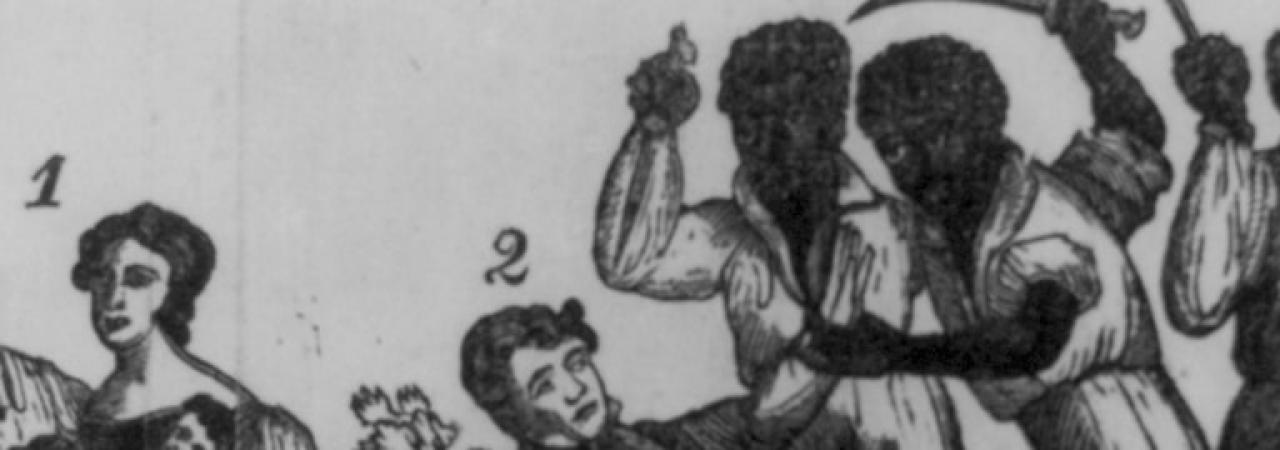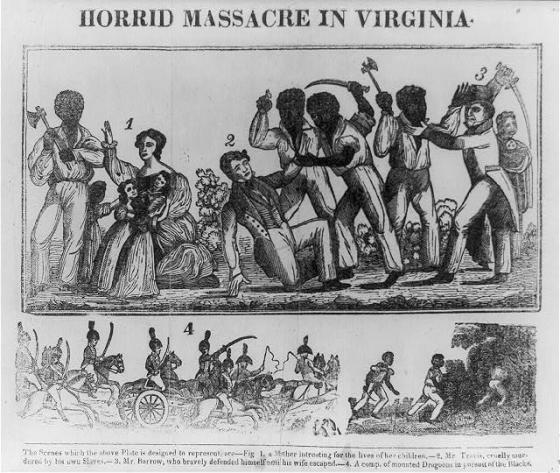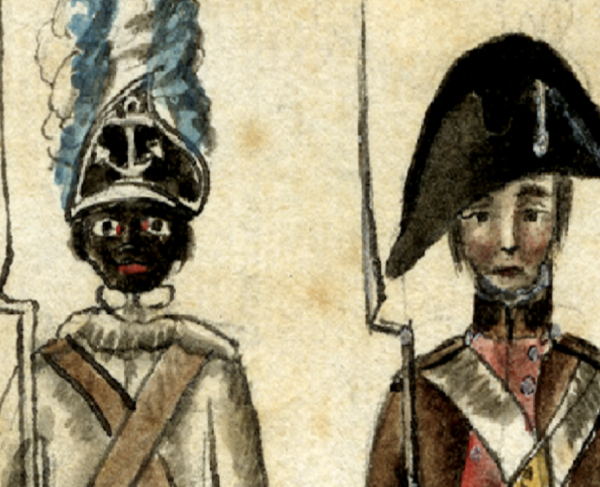Slave Rebellions and Uprisings

On Sunday, August 21, 1831, Nat Turner met in the forest on the outskirts of a Virginia plantation with six fellow slaves. With swords, muskets, axes, and other improvised weapons, the men went from house to house, farmstead to farmstead killing the white residents inside. Along the way, the group collected more slaves, as they headed from rural farmland toward Jerusalem, VA. The massacre continued for two days and resulted in the deaths of 55 men, women, and children. Growing up, Turner was deeply religious and isolated himself to meditate and pray. His family thought he was destined for great things by abnormal birthmarks and “visions” that he shared with them. Turner thought that this rebellion could show the fundamental errors of slavery and was what God had destined him to do. While he evaded pursuers for several months, he was eventually located and captured. In prison, he revealed his justification and admitted his crimes to Thomas R. Gray, an attorney who published these confessions in the pamphlet The Confessions of Nat Turner. Turner was hanged on November 11, 1831. Virginia executed, punished, or deported 55 other slaves who were complicit with the uprising. White militias and mobs killed another 120 slaves that had no connection to the rebellion because they were worried about a future rebellion. Laws were subsequently passed to limit the education of slaves and their movements between cities. However, this slave rebellion was not the first rebellion in the United States undertaken by slaves to gain their freedom.

Slavery, and slave rebellions, began with the colonization of the “New World.” The first slave rebellion was in San Miguel de Gualdape, a Spanish colony on the coast of present-day Georgia in 1526. After surveying this coast five years earlier, Lucas Vázquez de Ayllón, a wealthy sugar planter on the island of Hispaniola in the Caribbean, establish a colony. In the summer of 1521, he set off with 600 to 700 men, women, children, and African slaves to settle this new land. After losing supplies and having difficulty finding a proper site for settlement, San Miguel de Gualdape was the first European settlement in what became the continental United States. It was also the first documented case of Black slavery in continental North America. Unfortunately for the settlement, disease, starvation, and violence were prevalent. On October 8, Ayllón succumbed to disease. Fights between the remaining colonists broke out on whether to stay in the colony of return to Hispaniola. Amongst these fights, the African slaves brought to the colony rebelled and set fire to several buildings and escaped into the North American countryside. This was the first slave rebellion on land that was to become the continental United States. The settlers fled back to Hispaniola and never returned.
Colonists continued to settle North America and continued to import African slaves to work the land. Around 600,000 African slaves were transported to the present-day United States. In 1729, 65% of South Carolina’s 18,000 population were enslaved men and women kidnapped and transported from Africa. Those that were bought and sold in the Southern Colonies overwhelmingly became laborers in agriculture, specifically cash crops like tobacco, rice, and indigo (and later cotton). Of those that were transported to the North, many were household slaves or worked in shipyards. Between 1751 and 1775, 144,468 slaves were transported to the Thirteen Colonies. While the Thirteen Colonies fought for “life, liberty, and the pursuit of happiness” slavery continued. Some slaves were given their freedom through the war, such as Black Loyalists that joined Lord Dunmore’s Ethiopian Regiment. On the American side, the issue of slavery, and the arming of African Americans was a hot button topic. While the Northern Colonies advocated for the enlistment of African Americans to serve in the Continental Army, the Southern Colonies, led by South Carolina, strongly opposed these measures. George Washington, a slave owner himself, allowed African Americans to serve in his army after Rhode Island raised a regiment of black soldiers. However, most remained in bondage as “the slavery debate” was largely postponed by the Founding Fathers to be dealt with after the Revolutionary War.
With the invention of the cotton gin in 1793, cotton became the main crop of the South and slaves were needed to work on large plantations in the South to increase profit margins. As more slaves were transported South, the Northern states began to repeal slave laws and eight Northern states prohibited slavery by 1800.
In 1800, Gabriel, sometimes known erroneously as Gabriel Prosser, planned a rebellion in Richmond. He was born into slavery at a tobacco plantation in Virginia owned by Thomas Prosser. Gabriel, his brothers, and his father were all trained as blacksmiths and were taught how to read and write. While Gabriel’s exact motives are unclear, he planned a slave uprising, where, he would collect enslaved Africans along the route to Richmond, VA., and then attack the city. Before his plan could solidify, two slaves on another plantation told their owner, Mosby Sheppard, about the impending uprising. Sheppard notified the state militia to search for and arrest Gabriel. For a time, Gabriel was able to hide in a nearby town but was eventually captured and hanged with his two brothers and 23 other slaves. In response, Virginia attempted to limit the number of free blacks in the area, who had either bought their freedom or immigrated from the Caribbean with their freedom, to limit the influence slaves received of an emancipated life.
In response to protests about slavery, the federal government did regulate the slave trade and limit its reach. The Act Prohibiting Importation of Slaves took effect in 1808. The act prohibited the importation of slaves into the United States. However, owning of and the sale of slaves, was still legal in nine states and politicians, hoping to contribute to slavery’s longevity, were hoping to secure slavery in new territories. That same year Virginia barred anyone from teaching slaves how to read or write in fear of more insurrections. Slavery persisted, and slave rebellions continued.

The 1811 German Coast Uprising, which was the largest slave uprising in the United States, happened in present-day Louisiana a year before the territory became a state. This area had large plantations that utilized large numbers of slaves for agriculture cultivation. Some 90% of the white population owned at least one slave and slaves outnumbered the white population 5 to 1. Miles away in New Orleans, the free Black population increased to 5,000 people and boasted a degree of wealth.
Because of the density of slaves and the proximity of free blacks in the region, plantation owners were wary of insurrection. On January 6, 1811, several enslaved men met to finalize plans of an uprising along the coast. Two days later the slaves banded together and killed the son of their plantation owner. With farming equipment and other tools, the group’s size increased exponentially as they made their way from plantation to plantation along the coast. The numbers reached 200 slaves. Unlike Nat Turner’s Rebellion, the uprising only killed two white men in total. By January 10, a local militia had begun to tail the rebellion and killed 40 to 45 of the insurrectionists. Over the next couple of days, the insurrection was extinguished, and many of the slaves had been arrested. Between the battle, the apprehensions, and the following executions of the arrested slaves, 95 enslaved men died. United States militia presence grew in the area, to the relief of plantation owners and the chagrin of slaves. Louisiana was ratified as a slavery supporting state the subsequent year.
Slave masters attempted to stop slave insurrections before they began. Denmark Vesey was rumored to be organizing a large slave insurrection in 1818 in Charleston, South Carolina. Originally, he was born into slavery in Bermuda and was able to buy his freedom after being brought to the United States. However, he was unable to buy the freedom of his child or his wife and consequently remained in the area in which they were held in bondage. Vesey owned a carpentry business in the district and was a lay preacher in the African Methodist Episcopal (AME) Church, the only African American church in the district. Through these ventures, he was able to drum up support for an insurrection with a large majority of the African Americans, both free and enslaved within the city. They planned to secure weapons, collect as many people as they could, and then make their way to the newly freed Haiti. With many knowing of the plan, word eventually got out to a white slave master. He immediately formed a citizen’s militia. This militia slowly began to round up coconspirators and Vesey was eventually hanged for his conspiracy. In response, the church that Vesey worked for was forced to disband, the minister forced to flee, and public gatherings of African American scrutinized.
Slave rebellions and uprising ended with the abolishment of slavery on December 6, 1865, with the ratification of the Thirteenth Amendment. With the passage of this amendment, slaves no longer needed to use physical violence to gain their freedom. However, racial violence still continued into the postwar decades and the Jim Crow Era. Still, the memory of those who fought for their freedom remains.
Further Reading
- My Bondage and My Freedom By: Frederick Douglass
- The Fires of Jubilee: Nat Turner's Fierce Rebellion By: Stephen B. Oates
- American Uprising: The Untold Story of America's Largest Slave Revolt By: Daniel Rasmussen


